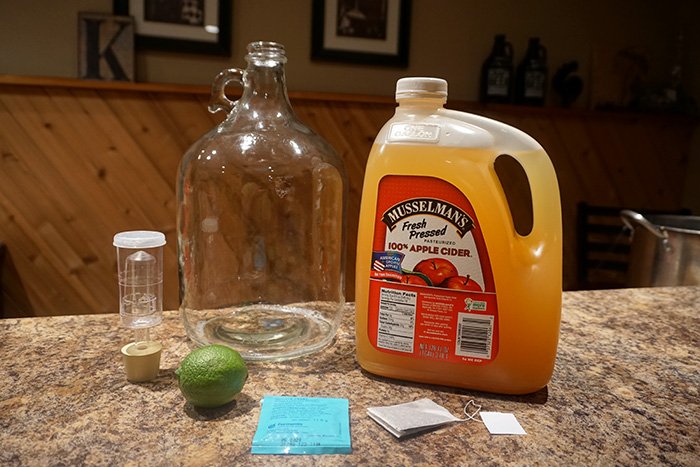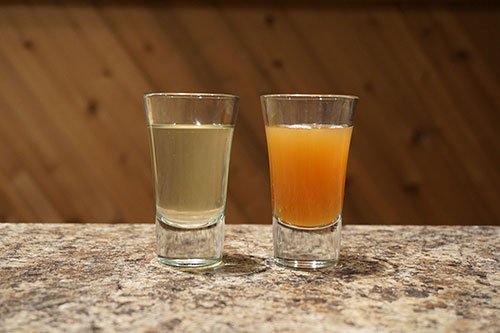Are you tired of filling and capping bottles? Kegging and force carbonating hard cider has many benefits over traditional bottling and while it requires more equipment, finishing cider in a keg is totally worth it!
Whether your cider has been bulk aged or is only a few weeks old, carbonating in the keg will allow for safe back sweetening, sediment-free pours, and guaranteed carbonation. This process reduces the guesswork, oxygen and infection exposure, and saves a ton of time!

Simple Steps to Keg and Carbonate Cider
- Clean and Sanitize Equipment
- Purge Keg with CO2
- Siphon Cider Into the Keg
- Purge Headspace with CO2
- Seal Keg
- Charge with CO2
Clean and sanitize the keg and all equipment before beginning. A good practice is to disassemble the inlet and outlet poppets, remove the dip tube and soak everything. Especially the first time you use the keg. At this time, inspect all of the seals and replace if needed.
With the keg reassembled and lid off, attach the CO2 to the gas in poppet, purge the air from the keg with CO2 to remove any oxygen. Oxygen in the keg can cause oxidation which will make your cider to taste like cardboard!

Once the keg is purged, siphon the finished cider into the corny keg using an auto siphon. I like to place the lid over the opening to reduce the chance of anything falling or blowing in.
When the keg is full, install the lid and slowly turn on the CO2 to check for leaks. Turn up the CO2 pressure to about 15psi, or your desired force carbonation pressure.
While all of the headspace in the keg should be CO2, some air may have made its way into the keg during the filling process. To remove the air, simply purge the keg a couple of times by pulling the relief valve (ball lock keg) or removing the GAS fitting and pushing down on the poppet (pin lock keg). Verify inlet and outlet so you do not get a cider shower!
Carbonating:
I prefer a lot of carbonation in my ciders, like tonic water explosion carbonation (some may say over carbonated). I like the back of my throat tingling!
Cider does not typically create a head like beer because it does not contain the proteins that beer does. This means that you can carbonate cider much higher than a beer without foaming and over carbonation issues (to a point). You can certainly overdo it though, think of opening a bottle of mineral water that gushes without being shaken.
To carbonate the keg of cider, connect the CO2 tank to the gas inlet fitting and set the regulator to approximately 15psi. Place the keg in a refrigerator or cool location for a few days to allow the CO2 to dissolve and force carbonate the cider.
A carbonation calculator can be used to calculate the precise amount of carbonation for your cider based on your preferences.

Quick Carbonating Cider:
To quickly force carbonate cider, start by cooling the cider to serving temperature. Cold liquids accept and retain CO2 better than warm liquids.
Connect the CO2 to the gas inlet poppet and set the regulator to approximately 30psi. Place the keg on its side and rock it back and forth. You will be able to hear the gas flow from the tank into the keg as it is absorbed into the cider. After a minute or two of rocking the keg, you will notice it stops accepting CO2.
Reduce the CO2 regulator pressure to serving pressure, 8-12psi, and burp the keg to release excess pressure. Forgetting to purge isn’t a huge deal, although that first pint may come out very quickly.
The cider can now be placed into a kegerator to chill. Allow the cider to rest for a while as it will be foamy from the agitation.

Serving Pressures For Kegged Cider:
Once the hard cider is carbonated, the CO2 regulator pressure should be reduced to serving pressure. The typical serving pressure is 8-12 psi which will dispense the liquid and fill the new headspace in the keg to keep the remaining cider carbonated.
Over Carbonation:
Over carbonation can happen when force carbonating, especially when quick carbonating at higher pressures. Over carbonating can be identified when you pour a glass of cider and nothing but foam comes out or the glass overflows easily with head.
To fix over carbonation in a kegged cider, simply disconnect the CO2 and purge the keg. Before reconnecting the gas hose, allow the cider to rest. This will allow the CO2 to escape the carbonated cider and pressurize the empty headspace of the keg thus reducing the carbonation.
Repeat this step a few times to reduce the amount of CO2 in the cider, similar to how a glass of cider would eventually go flat. But, before the cider becomes flat, reconnect the CO2 at serving pressure and pour a test glass.

Leaking Keg Lid:
A lot of the corny kegs available to home cider makes are used soda kegs that can be a bit beat up. If your lid will not seal easily, check the seals to make sure they are soft and not cracked or gouged.
Insert the lid and seat in place. Grab onto the lid latch like a handle and pull up on the lid. While pulling up on the lid, lifting the keg off the ground, attach the CO2 to pressurize the keg and force the lid to seal using the gas pressure. Once sealed, secure the lid latch as normal.
Hard Cider Kegging Equipment
If you are looking for kegging equipment, I wrote an article to help you find what you need to keg hard cider.








After searching for a few weeks for information on carbing cider this information was perfect and concise. Thanks for all the help.
How can I add very little sweetness to my dry cider. Just a little!
Simply add apple juice when you serve the cider. When you use a yeast like Champagne, it can make a dry bone cider (all the sugars converted to alcohol). I find it is not a problem when you add apple juice in the glass. Some will like to make it sweeter, and less strong other will enjoy the very dry cider.
If you want sweeter cider, use a zero-calorie low glycemic sweetener like Stevia or a
sugar alcohol like Xylitol (great for humans, poison for dogs…). Any sweetener that is zero-calorie means that yeast cannot eat it–so yes, you can use the chemical stuff too (pink, blue, Splenda, etc…).
I would not recommend Stevia, that makes a bad after taste. I personally use apple juice concentrate, but that gives a very sweet flavor, so adjust accordingly. Not to mention, your introducing sugar to the batch and will start the fermentation again if you have not already destroyed the yeast. Happy Hard Cider Making!
If kegging and storing in a refrigerator, even if back-sweetening with frozen, concentrated apple juice, is it really necessary to “stop all fermentation”?
Yes if you want to store it for months. Stabilise with Potassium Sorbate after Campden tablets to kill the yeast and stop fermentation to sugars introduced by back sweetening.